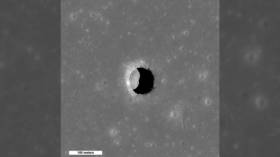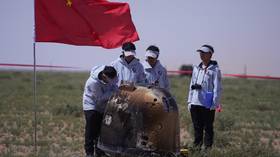Researchers pinpoint potential Moon base site

The possible existence of a large cave at the bottom of a deep crater on the Moon could protect humans from environmental hazards during extended expeditions, an Italian-led study has suggested.
A paper published in the Nature Astronomy journal on Monday describes radar data collected by the Lunar Reconnaissance Orbiter (LRO) in 2010. Some of it suggests that the Mare Tranquillitatis (Sea of Tranquillity) pit could host a potential base for future exploration of the Earth's natural satellite.
The crater is a landmark feature roughly 400 km from Tranquility Base, where the Apollo 11 mission landed in 1969. It is the deepest known lunar pit, estimated to be 100 meters below the surface.
Data collected by the LRO’s Mini-RF suggests that it may actually be a “skylight” overhanging a sloping floor of a cave 150 meters deep, 45 meters wide and 80 meters long, Lorenzo Bruzzone, of the University of Trento in Italy, explained to the media.
The cave is “probably an empty lava tube” and could shelter human habitats, he said. There may also be reserves of frozen water inside, a valuable resource for any manned mission, the scientist added.
The lunar surface is exposed to a variety of factors harmful for humans, including space radiation, cosmic rays and micrometeorites. Hiding bases underground has been one of the proposed ways of mitigating them.
Scientists have long theorized that some pits on the Moon may lead to lava caves that could serve the purpose. But their stability may prove to be an issue, with walls and ceiling requiring reinforcement.
”The main advantage of caves is that they make available the main structural parts of a possible human base without requiring complex construction activities,” said Leonardo Carrer, the study’s first author.
In addition to practical benefits, lava tubes would contain rock and soil samples that have not been affected by the degrading conditions on the surface and could give insights into the formation of the Moon and seismic activity.














